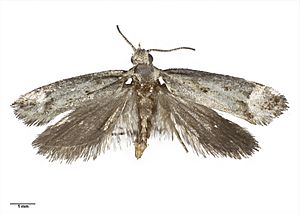Lysiphragma argentaria facts for kids
Quick facts for kids Lysiphragma argentaria |
|
|---|---|
 |
|
| Male holotype | |
| Scientific classification | |
| Kingdom: | |
| Phylum: | |
| Class: | |
| Order: | |
| Family: | |
| Genus: |
Lysiphragma
|
| Species: |
L. argentaria
|
| Binomial name | |
| Lysiphragma argentaria Salmon, 1948
|
|
Lysiphragma argentaria is a species of moth in the family Tineidae. It is endemic to New Zealand. It is classified as "At Risk, Naturally Uncommon" by the Department of Conservation.
Contents
Taxonomy
This species was first described by John Tenison Salmon in 1948 using a specimen collected by Graham Turbott on the 22 April 1946 on Great Island at the Three Kings Islands. The family level classification of this endemic moth is regarded as unsatisfactory, and it is not correctly placed in the genus Lysiphragma. As such the species is currently also known as Lysiphragma (s.l.) argentaria. The holotype specimen is held at the Auckland War Memorial Museum.
Description
Salmon described this species as follows:
The expansion of the wings is 12 mm. The general colour is silvery white on the forewings and head ; pale grey on the thorax ; with patagia whitish ; pale-ochreous white on the abdomen and silvery-grey on the hind wings, with strong metallic reflections. The forewings are clouded with scattered grey scales along the costa from the base to about three-quarters ; there is an apical cloudy-grey patch and a similar sub-apical patch on the tornus ; basal streak marked by a line of yellowish-orange terminated by two or three very dark-brown scales. Cilia of the forewings pale-brown, of the hind wings silvery-grey. The costa of the forewings is gently arched, the dorsum almost straight, the apex rounded and acute. Antennae dark-brown banded with white ; palpi brown shaded with white. Head and thorax heavily scaled. Legs greyish-white.
Distribution
This species is endemic to New Zealand. It is only found on the Three Kings Islands.
Biology and behaviour
Much of the biology of this species is unknown. This species is attracted to light. Adults of this species are on the wing in April.
Host species and habitat
The holotype specimen was collected on a "tea tree".
Conservation Status
This species has been classified as having the "At Risk, Naturally Uncommon" conservation status under the New Zealand Threat Classification System.
 | Jackie Robinson |
 | Jack Johnson |
 | Althea Gibson |
 | Arthur Ashe |
 | Muhammad Ali |

